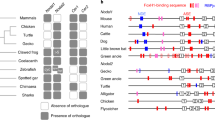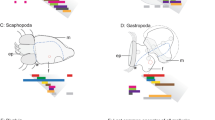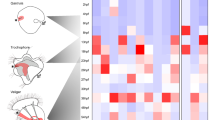Abstract
Many animals display specific internal or external features with left–right asymmetry. In vertebrates, the molecular pathway that leads to this asymmetry uses the signalling molecule Nodal, a member of the transforming growth factor-β superfamily1, which is expressed in the left lateral plate mesoderm2, and loss of nodal function produces a randomization of the left–right asymmetry of visceral organs3,4. Orthologues of nodal have also been described in other deuterostomes, including ascidians and sea urchins5,6, but no nodal orthologue has been reported in the other two main clades of Bilateria: Ecdysozoa (including flies and nematodes) and Lophotrochozoa (including snails and annelids). Here we report the first evidence for a nodal orthologue in a non-deuterostome group. We isolated nodal and Pitx (one of the targets of Nodal signalling) in two species of snails and found that the side of the embryo that expresses nodal and Pitx is related to body chirality: both genes are expressed on the right side of the embryo in the dextral (right-handed) species Lottia gigantea and on the left side in the sinistral (left-handed) species Biomphalaria glabrata. We pharmacologically inhibited the Nodal pathway and found that nodal acts upstream of Pitx, and that some treated animals developed with a loss of shell chirality. These results indicate that the involvement of the Nodal pathway in left–right asymmetry might have been an ancestral feature of the Bilateria.
This is a preview of subscription content, access via your institution
Access options
Subscribe to this journal
Receive 51 print issues and online access
$199.00 per year
only $3.90 per issue
Buy this article
- Purchase on Springer Link
- Instant access to full article PDF
Prices may be subject to local taxes which are calculated during checkout




Similar content being viewed by others
Accession codes
Data deposits
Nodal, Pitx and hedgehog sequences of L. gigantea and B. glabrata are deposited at the EMBL-GenBank data libraries; accession numbers EU394708 and EU394707 (for nodal), EU797117 and EU797116 (for Pitx) and EU394706 and EU394705 (for hedgehog). In addition, a brachyury sequence of L. gigantea is deposited as accession number EU797118.
References
Massagué, J. & Gomis, R. R. The logic of TGFβ signaling. FEBS Lett. 580, 2811–2820 (2006)
Hamada, H., Meno, C., Watanabe, D. & Saijoh, Y. Establishment of vertebrate left–right asymmetry. Nature Rev. Genet. 2, 103–113 (2002)
Supp, D. M., Witte, D. P., Potter, S. S. & Brueckner, M. Mutation of an axonemal dynein affects left–right asymmetry in inversus viscerum mice. Nature 389, 963–966 (1997)
Okada, Y. et al. Abnormal nodal flow precedes situs inversus in iv and inv mice. Mol. Cell 4, 459–468 (1999)
Morokuma, J., Ueno, M., Kawanishi, H., Saiga, H. & Nishida, H. HrNodal, the ascidian nodal-related gene, is expressed in the left side of the epidermis, and lies upstream of HrPitx . Dev. Genes Evol. 212, 439–446 (2002)
Duboc, V., Rottinger, E., Besnardeau, L. & Lepage, T. Nodal and BMP2/4 signaling organizes the oral–aboral axis of the sea urchin embryo. Dev. Cell 6, 397–410 (2004)
Duboc, V., Rottinger, E., Lapraz, F., Besnardeau, L. & Lepage, T. Left–right asymmetry in the sea urchin embryo is regulated by nodal signaling on the right side. Dev. Cell 9, 147–158 (2005)
Schilthuizen, M. & Davison, A. The convoluted evolution of snail chirality. Naturwissenschaften 92, 504–515 (2005)
Boycott, A. E. & Diver, C. On the inheritance of sinistrality in Limnaea peregra . Proc. R. Soc. Lond. B 95, 207–213 (1923)
Sturtevant, A. H. Inheritance of direction of coiling in Limnaea . Science 58, 269–270 (1923)
Freeman, G. & Lundelius, J. The developmental genetics of dextrality and sinistrality in the gastropod Lymnaea peregra . Wilhelm Roux Arch. Dev. Biol. 191, 69–83 (1982)
Nederbragt, A. J., van Loon, A. E. & Dictus, W. J. Evolutionary biology: hedgehog crosses the snail’s midline. Nature 417, 811–812 (2002)
van den Biggelaar, J. A. M., van Loon, A. E. & Damen, W. G. M. Mesentoblast and trochoblast specification in species with spiral cleavage predict their phyletic relations. Neth. J. Zool. 46, 8–21 (1995)
Lartillot, N., Lespinet, O., Vervoort, M. & Adoutte, A. Expression pattern of Brachyury in the mollusc Patella vulgata suggests a conserved role in the establishment of the AP axis in Bilateria. Development 129, 1411–1421 (2002)
Dictus, W. J. A. G. & Damen, P. Cell lineage and clonal-contribution map of the trochophore larva of Patella vulgata (Mollusca). Mech. Dev. 62, 213–226 (1997)
Inman, G. J. et al. SB-431542 is a potent and specific inhibitor of transforming growth factor-β superfamily type I activin receptor-like kinase (ALK) receptors ALK4, ALK5, and ALK7. Mol. Pharmacol. 62, 65–74 (2002)
Christiaen, L. et al. Evolutionary modification of mouth position in deuterostomes. Semin. Cell Dev. Biol. 18, 502–511 (2007)
Nogi, T., Yuan, Y. E., Sorocco, D., Perez-Tomas, R. & Levin, M. Eye regeneration assay reveals an invariant functional left–right asymmetry in the early bilaterian, Dugesia japonica . Laterality 10, 193–205 (2005)
Oviedo, N. J. & Levin, M. Gap junctions provide new links in left–right patterning. Cell 129, 645–647 (2007)
Ponder, W. F. & Lindberg, D. R. Towards a phylogeny of gastropod molluscs: analysis using morphological characters. Zool. J. Linn. Soc. 119, 83–265 (1997)
Hibino, T., Nishino, A. & Amemiya, S. Phylogenetic correspondence of the body axes in bilaterians is revealed by the right-sided expression of Pitx genes in echinoderm larvae. Dev. Growth Differ. 48, 587–595 (2006)
Palmer, A. R. Symmetry breaking and the evolution of development. Science 306, 828–833 (2004)
Duboc, V. & Lepage, T. A conserved role for the Nodal signaling pathway in the establishment of dorso–ventral and left–right axes in deuterostomes. J. Exp. Zool. B Mol. Dev. Evol. 310, 41–53 (2008)
Levin, M. Left–right asymmetry in embryonic development: a comprehensive review. Mech. Dev. 122, 3–25 (2005)
Gould, M. C., Stephano, J. L., Ortíz-Barrón, B. J. & Pérez-Quezada, I. Maturation and fertilization in Lottia gigantea oocytes: intracellular pH, Ca2+, and electrophysiology. J. Exp. Zool. 290, 411–420 (2001)
Price, A. L. & Patel, N. H. Investigating divergent mechanisms of mesoderm development in arthropods: the expression of Ph-twist and Ph-mef 2 in Parhyale hawaiensis . J. Exp. Zoolog. B Mol. Dev. Evol. 310, 24–40 (2008)
Shibazaki, Y., Shimuzu, M. & Kuroda, R. Body handedness is directed by genetically determined cytoskeletal dynamics in the early embryo. Curr. Biol. 14, 1462–1467 (2004)
Camey, T. & Verdonk, N. H. The early development of the snail Biomphalaria glabrata (Say) and the origin of the head organs. Neth. J. Zool. 20, 93–121 (1970)
Acknowledgements
We thank E. Begovic, E. E. Gonzales and I. Martínez-Solano for help collecting and fertilizing L. gigantea. A. Almeida helped with the drug experiments. D. R. Lindberg provided the Busycon pulleyi specimen. The NIAID Schistosomiasis Resource Center provided adults of B. glabrata. We thank M. Levine, D. R. Lindberg, P. Liu, M. Modrell, S. Nichols, M. Protas and J. Rehm for comments on the manuscript, and I. Hariharan for suggesting the experiments with rapamycin. C.G. was sponsored by a postdoctoral fellowship of the Ministerio de Educacion y Ciencia (Spain) and the Center for Integrative Genomics. N.H.P. is an Investigator of the Howard Hughes Medical Institute.
Author Contributions C.G. performed experiments; C.G. and N.H.P. designed experiments, collected and analysed data, and wrote the manuscript.
Author information
Authors and Affiliations
Corresponding author
Supplementary information
Supplementary Information
This file contains Supplementary Figures 1-5 with Legends, Supplementary Tables 1-3, Supplementary Methods and Supplementary Results (PDF 3065 kb)
Rights and permissions
About this article
Cite this article
Grande, C., Patel, N. Nodal signalling is involved in left–right asymmetry in snails. Nature 457, 1007–1011 (2009). https://doi.org/10.1038/nature07603
Received:
Accepted:
Published:
Issue Date:
DOI: https://doi.org/10.1038/nature07603
This article is cited by
-
Genome-wide investigation of the TGF-β superfamily in scallops
BMC Genomics (2024)
-
The Secrets of the Frogs Heart
Pediatric Cardiology (2022)
-
Duplication of spiralian-specific TALE genes and evolution of the blastomere specification mechanism in the bivalve lineage
EvoDevo (2021)
-
Pitx controls amphioxus asymmetric morphogenesis by promoting left-side development and repressing right-side formation
BMC Biology (2021)
-
The pond snail Lymnaea stagnalis
EvoDevo (2020)
Comments
By submitting a comment you agree to abide by our Terms and Community Guidelines. If you find something abusive or that does not comply with our terms or guidelines please flag it as inappropriate.



